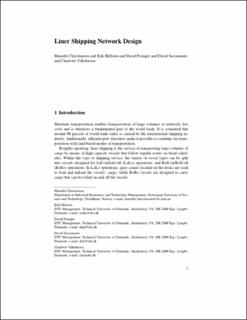| dc.contributor.author | Christiansen, Marielle | |
| dc.contributor.author | Hellsten, Erik | |
| dc.contributor.author | Pisinger, David | |
| dc.contributor.author | Sacramento, David | |
| dc.contributor.author | Vilhelmsen, Charlotte | |
| dc.date.accessioned | 2022-12-29T15:23:19Z | |
| dc.date.available | 2022-12-29T15:23:19Z | |
| dc.date.created | 2021-09-28T14:14:37Z | |
| dc.date.issued | 2021 | |
| dc.identifier.isbn | 978-3-030-64017-0 | |
| dc.identifier.uri | https://hdl.handle.net/11250/3039946 | |
| dc.description.abstract | Liner shipping is the service of transporting large volumes of cargo using ocean-going vessels, sailing regular routes on fixed schedules. Designing a good network is a complex task, in which many aspects have to be taken into account. We give a brief introduction to containerised liner shipping, RoRo liner shipping, and network design. We also introduce the LINER-LIB test instances for network design in containerised liner shipping. The most common network design models for containerised liner shipping are presented, including, integrated Mixed Integer Programming (MIP) models, and two-stage algorithms where the service generation and the flowing of containers are separated into two steps. We conclude the chapter by discussing future trends in liner shipping, indicating directions for future research. | en_US |
| dc.language.iso | eng | en_US |
| dc.publisher | Springer | en_US |
| dc.relation.ispartof | Network Design with Applications to Transportation and Logistics | |
| dc.title | Liner Shipping Network Design | en_US |
| dc.title.alternative | Liner Shipping Network Design | en_US |
| dc.type | Chapter | en_US |
| dc.description.version | acceptedVersion | en_US |
| dc.source.pagenumber | 469-505 | en_US |
| dc.identifier.doi | 10.1007/978-3-030-64018-7_15 | |
| dc.identifier.cristin | 1939864 | |
| dc.relation.project | Norges forskningsråd: 263031 | en_US |
| cristin.ispublished | true | |
| cristin.fulltext | postprint | |
| cristin.qualitycode | 1 | |
